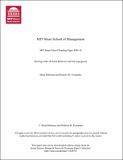| dc.contributor.author | Rubineau, Brian | |
| dc.contributor.author | Fernandez, Roberto M. | |
| dc.date.accessioned | 2011-11-04T15:56:19Z | |
| dc.date.available | 2011-11-04T15:56:19Z | |
| dc.date.issued | 2009-06 | |
| dc.identifier.uri | http://hdl.handle.net/1721.1/66932 | |
| dc.description.abstract | How does referral recruitment contribute to job segregation, and what can organizations do about it?
Current theory on network effects in the labor market emphasizes the job-seeker perspective, focusing on the
segregated nature of job-seekers’ information and contact networks, and leaves little role for organizational
influence. But employee referrals are necessarily initiated from within a firm by referrers. We argue that
referrer behavior is the missing link that can help organizations manage the segregating effects of referring.
Adopting the referrer’s perspective of the process, we develop a computational model which integrates a set
of empirically documented referrer behavior mechanisms gleaned from extant organizational case studies.
Using this model, we compare the segregating effects of referring when these behaviors are inactive to the
effects when the behaviors are active. We show that referrer behaviors substantially boost the segregating
effects of referring. This impact of referrer behavior presents an opportunity for organizations. Contrary to
popular wisdom, we show that organizational policies designed to influence referrer behaviors can mitigate
most if not all of the segregating effects of referring. | en_US |
| dc.language.iso | en_US | en_US |
| dc.publisher | Cambridge, MA; Alfred P. Sloan School of Management; Massachusetts Institute of Technology | en_US |
| dc.relation.ispartofseries | MIT Sloan School of Management Working Paper;4784-10 | |
| dc.title | Missing Links: Referrer Behavior and Job Segregation | en_US |
| dc.type | Working Paper | en_US |
